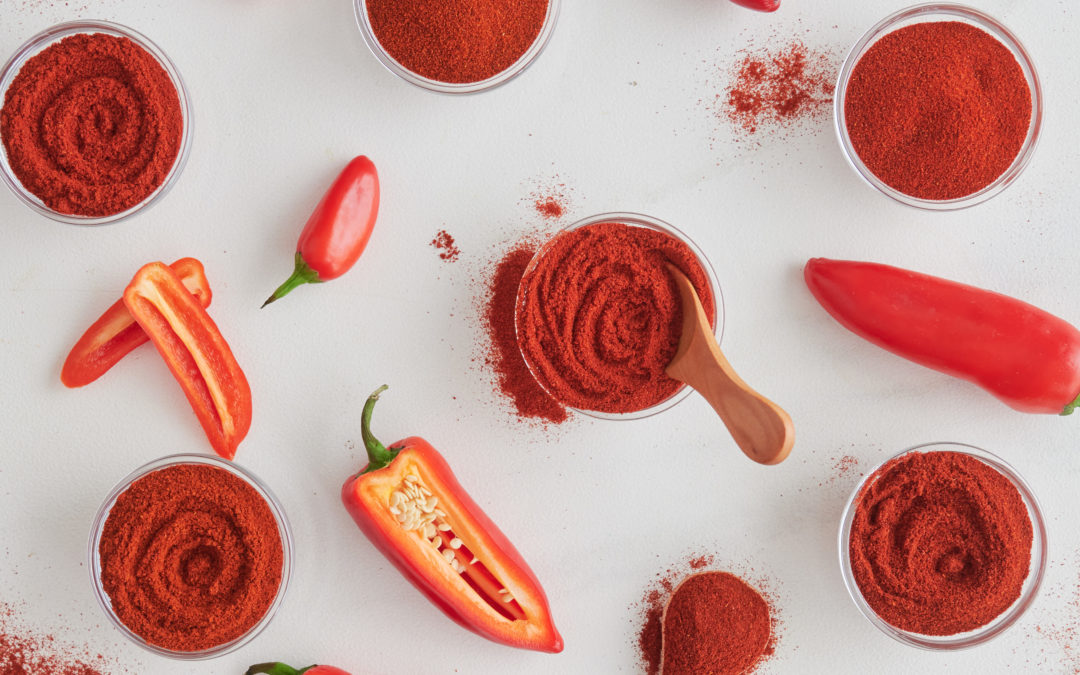A classic kitchen mainstay, paprika is a bright and bold spice with a range of flavors and culinary applications, plus a rich and colorful history to match.
Paprika is not only prevalent in Mexican food, it is the national spice of Hungary and is popular around the world, including the Middle East, Europe, and North America. Cultivated around the world, there are many types of paprika on the market today that offer endless opportunities for culinary experimentation.
In this blog, we’ll discuss the history, origins, and common uses for the iconic, bright red kitchen spice, Paprika.
History
The Capsicum annuum plant is a New Word fruit, believed to have originated in Mexico. Based on recent findings, experts believe that the peppers of the plant may have been consumed for thousands of years, making it a categorically ancient spice. In ancient times, paprika was used by indigenous people for culinary reasons and as a red dye for textiles, and is still used as a culinary and textile dyeing agent today.
Paprika was introduced to Europe when peppers were brought back to the Old World in the 16th century (according to some accounts by Christopher Columbus himself). When they arrived in Europe, Spanish monks began cultivating the plant. They hung the peppers in smokehouses and dried and ground them into powder in ancient stone mills. Today, some of the best smoked paprika is still made in La Vera, Extremadura (a county in western Spain). In Spain, paprika is sold in variations labeled dulce (sweet) picante (spicy), agridulce (medium) and pimentón (smoked).
The Turks (of the Ottoman Empire) brought chili peppers to Hungary, where paprika became a cornerstone spice in traditional Hungarian dishes, flavoring staples such as goulash. In the mid 1800s, Hungarians gave paprika the great honor of naming it their National Spice.
When the French “King of Chefs” Georges Escoffier featured paprika on his menu in the late 1800s, it became popularized in the culinary world. Since then, paprika has been a spice cabinet mainstay for home cooks and elite chefs alike.
Flavor
The flavor of paprika is not homogenous, and has a range of flavors depending on variety, origin, and preparation.
Generally, paprika is prepared by removing the seeds and membranes from the fruit before processing and grinding, resulting in a mild, fruity, bitter but sweet flavor without heat.
Smoked paprika is prepared by first smoking the peppers over oak wood fires, adding a distinctive smoky flavor to the final product.
A Note on Terminology:
Because paprika is made from the same Capsicum annuum species from which many other pepper products are made, the word paprika itself is sometimes used differently by people in varying regions and by different companies. You may see the term “hot paprika” used to refer to spicy varieties that are made by including the seeds, placenta, stalk, and calyx of the peppers during processing to give it heat; those that use that term will then refer to the mild varieties as “sweet paprika”. However most American companies, including Pacific Spice, don’t refer to the hot varieties as paprika – those are separately categorized as “ground chili” or “ground chili pepper”. The mild, sweet version is therefore simply called paprika (with smoked paprika being the smoky variation). So when you read about paprika (in a blog post like this one!) or see a recipe that calls for paprika without any other descriptors, it’s safe to assume the author is referring to the mild, non-spicy variety.
To add more confusion: In languages other than English, the word paprika doesn’t only refer to the ground spice; it is used even more broadly to include the actual plant and whole peppers, and sometimes to include bell peppers and other varieties.
Appearance
Paprika is made of the dried and ground skins and flesh of chili peppers, which give the spice its signature red pigment. Although all peppers from the Capsicum annuum plant are genetically the same, the appearance of the peppers can vary dramatically from one another .
Chili pepper plants are herbaceous perennials that grow best in warm, dry climates. They are leafy plants that grow to about 2.5 feet, and are part of the nightshade family. The fruits of a chili pepper plant are hollow with a smooth, waxy skin that range in shape and size (depending on the variety).
Because there is so much variation within the species, The American Spice Trade Association (ASTA) came up with a special categorization system for paprika. Paprika is assigned what is called an ASTA number as a way to quantify its color pigment. The number indicates the spice’s vibrancy, a product of its carotenoid content. A high ASTA number signifies a bright, crimson red color, while a low ASTA number signifies a duller yellow/orange-red color.
Origin
The most common paprika-producing countries are Spain and Hungary, however, the plant is cultivated around the world; including China, Peru, Israel, and the United States.
Quality Sourcing/Safety
Pacific Spice is dedicated to producing the highest quality spices. That’s why we source our paprika only from approved vendors that exceed quality standards and meet our strict vendor guidelines. This results in a product that is pure, free of contaminants and adulterants, and a flavorful addition to your favorite dishes.
Storing
Paprika’s quality and color preservation is largely affected by its storage conditions. Paprika should always be tightly sealed and stored in a cool, dry, dark place; above ground and away from the wall. When it’s stored properly, the spice can stay fresh and bright for up to one year.
Uses
Because paprika is a highly versatile and varied product, it’s a common ingredient in a variety of dishes. Try it in:
- Goulash
- Deviled eggs
- Hummus
- Potato salad
- Meat rubs and marinades
- Sweet potatoes
In addition to savory recipes, paprika also appears in some sweet dishes such as chocolate chip cookies, and homemade granola.
PSC Paprika
If you are interested in ordering from PSC, contact us about our paprika products:
- PAPRIKA SMOKED SWEET
- PAPRIKA HUNGARIAN
- PAPRIKA DOMESTIC 85 ASTA
- PAPRIKA DOMESTIC 120 ASTA
- PAPRIKA SPANISH 120 ASTA
- PAPRIKA IMPORTED 120 ASTA
Talk to your sales rep today, and we’ll be happy to fill your order!

